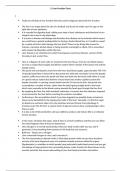Lecture notes
liver function test
- Module
- Clinical sciences
- Institution
- Aston University, Birmingham (Aston)
• The liver is an organ about the size of a football, and it just sits under your rib cage on the right side of your abdomen. • It is essential for digesting food, ridding your body of toxic substances and therefore has an integral role in day-to-day physiology. • It is prone to disease and...
[Show more]



